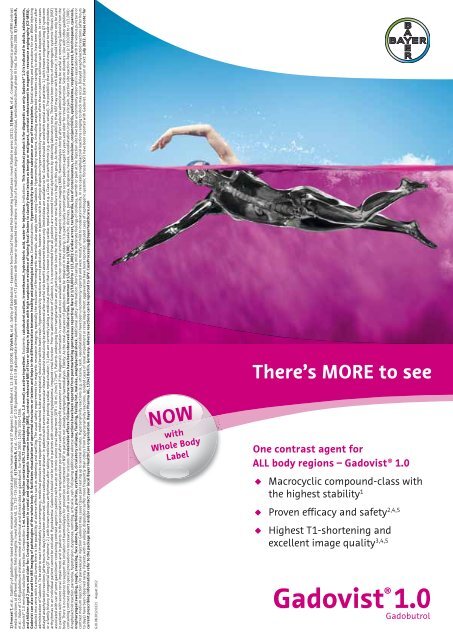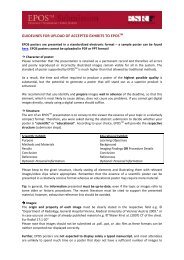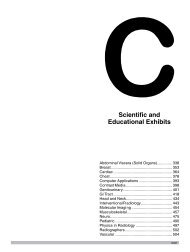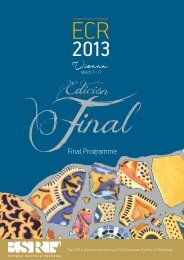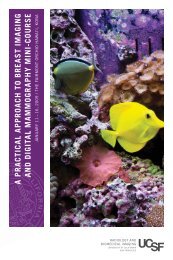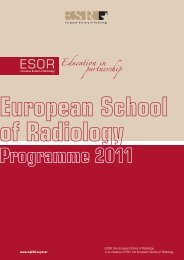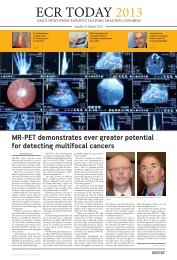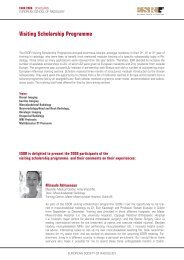New Horizons - myESR.org
New Horizons - myESR.org
New Horizons - myESR.org
- No tags were found...
Create successful ePaper yourself
Turn your PDF publications into a flip-book with our unique Google optimized e-Paper software.
1) Frenzel T, et al.: Stability of gadolinium-based magnetic resonance imaging contrast agents in human serum at 37 degrees C: Invest Radiol 43, 12: 817–828 (2008). 2) Voth M, et al.: Safety of Gadobutrol – Experience from Clinical Trials and Post-marketing Surveillance: Invest Radiol In press (2011). 3) Rohrer M, et al.: Comparison of magnetic properties of MRI contrastmedia solutions at different magnetic field strengths: Invest Radiol 40, 11: 715–724 (2005). 4) Tombach B, et al.: Comparison of 1.0 M gadobutrol and 0.5 M gadopentate dimeglumine-enhanced MRI in 471 patients with known or suspected renal lesions: results of a multicenter, single-blind, interindividual, randomized clinical phase III trial. Eur Radiol 2008. 5) Tombach B,et al.: Value of 1.0 M gadolinium chelates: review of preclinical and clinical data on gadobutrol. Eur Radiol 2002; 12(6): 1550–1556.Gadovist® 1.0 mmol/mL solution for injection. Composition: 1 mL solution for injection contains 604.72 mg gadobutrol (equiv. 1.0 mmol) as active ingredient. Excipients: calcobutrol sodium, tromethamol, hydrochloric acid, water for injections. Indications: This medicinal product is for diagnostic use only. Gadovist® 1.0 is indicated in adults, adolescents,and children aged 2 years and older for: Contrast enhancement in cranial and spinal magnetic resonance imaging (MRI), contrast enhanced MRI of liver or kidneys in patients with high suspicion or evidence of having focal lesions to classify these lesions as benign or malignant, contrast enhancement in magnetic resonance angiography (CE-MRA).Gadovist can also be used for MR imaging of pathologies of the whole body. It facilitates visualization of upnormal structures or lesions and helps in the differentiation between healthy and pathological tissue. Contraindications: Hypersensitivity to the active substance or any of the excipients. Special warnings and precautions for use: While injectingGadovist into veins with a small lumen there is the possibility of adverse effects such as reddening and swelling. The usual safety requirements for magnetic resonance imaging, especially the exclusion of ferromagnetic materials, also apply when using Gadovist. Hypersensitivity reactions, including anaphylactoid reactions ranging to shock, have been observed afteradministration of Gadovist. To be able to react immediately to an emergency, medicinal products and equipment (e.g. endotracheal tube and respirator) should be within hand reach. Hypersensitivity reactions are not predictable, however in patients with an allergic disposition hypersensitivity may occur more often than in patients without such a disposition. In rare casesdelayed anaphylactoid reactions (after hours to days) have been observed. Severe cardiovascular disease: In patients with severe cardiovascular disease Gadovist should only be administered after careful risk benefit assessment because only limited data are available so far. Gadovist should be used with special care in patients: 1.) with known congenital long QT syndromeor a family history of congenital long QT syndrome; 2.) with known previous arrhythmias after taking medicinal products that prolong cardiac repolarisation; 3.) who are currently taking a medicinal product that is known to prolong cardiac repolarisation e.g. a Class III antiarrhythmic (e.g. amiodarone, sotalol). The possibility that Gadovist may cause torsade de pointesarrhythmias in an individual patient cannot be excluded. Hypokalemia: Gadovist should not be used in patients with uncorrected hypokalemia. Impaired renal function: Prior to administration of Gadovist, it is recommended that all patients are screened for renal dysfunction by obtaining laboratory tests. There have been reports of nephrogenic systemic fibrosis (NSF)associated with use of some gadolinium-containing contrast agents in patients with acute or chronic severe renal impairment (GFR < 30 mL /min/1.73m 2 ). Patients undergoing liver transplantation are at particular risk since the incidence of acute renal failure is high in this group. As there is a possibility that NSF may occur with Gadovist, it should therefore only be usedin patients with severe renal impairment and in patients in the perioperative liver transplantation period after careful risk/benefit assessment and if the diagnostic information is essential and not available with non-contrast enhanced magnetic resonance imaging (MRI). Haemodialysis shortly after Gadovist administration may be useful at removing Gadovist from thebody. There is no evidence to support the initiation of haemodialysis for prevention or treatment of NSF in patients not already undergoing haemodialysis. Elderly: As the renal clearance of gadobutrol may be impaired in the elderly, it is particularly important to screen patients aged 65 years and older for renal dysfunction. Seizure disorders: Like with other gadoliniumcontaining contrast agents special precaution is necessary in patients with a low threshold for seizures. Undesirable effects: Following adverse reactions have been observed in clinical trials. Uncommon (≥ 1/1,000 to < 1/100): Headache, dizziness, paresthesia, dysgeusia, nausea, vasodilatation, injection site pain, injection site reaction. Rare (≥ 1/10,000 to < 1/1,000):Anaphylactoid reaction, parosmia, hypotension, dyspnoea, vomiting, urticaria, rash. Following additional adverse reactions have been reported from postmarketing spontaneous reporting: Rare (≥ 1/10,000 to < 1/1,000): Cardiac arrest, tachycardia, loss of consciousness, convulsion, conjunctivitis, eyelid oedema, respiratory arrest, bronchospasm, cyanosis,oropharyngeal swelling, cough, sneezing, face edema, hyperhidrosis, pruritus, erythema, circulatory collapse, flushing, feeling hot, malaise, anaphylactoid shock. Additional safety information: Short-lasting mild to moderate feelings of coldness, warmth or pain at the injection site have been uncommonly observed in association with the venous puncture orcontrast medium injection. On paravascular injection Gadovist may cause tissue pain lasting up to several minutes. Hypersensitivity reactions (e.g. urticaria, rash, vasodilatation) have been uncommonly reported and were mostly of mild to moderate intensity. In rare cases anaphylactoid reactions ranging to shock may occur. Delayed anaphylactoid reactions (after hoursto days) have been observed rarely. Patients with an allergic disposition suffer more frequently than others from hypersensitivity reactions. Isolated cases of renal impairment or renal impairment aggravation have been reported. Isolated cases of nephrogenic systemic fibrosis (NSF) have been reported with Gadovist. Date of revision of text: July 2012. Please note: forcurrent prescribing information refer to the package insert and/or contact your local Bayer HealthCare <strong>org</strong>anisation. Bayer Pharma AG, 13342 Berlin, Germany. Adverse reactions can be reported to GPV. CaseProcessing@bayerhealthcare.comG.DI.08.2012.0221 August 2012NOWwithWhole BodyLabelWhen Safety There’s Matters MORE to Most seeOne contrast agent forALL body regions – Gadovist® 1.0Q Macrocyclic compound-class withthe highest stability 1Q Proven efficacy and safety 2,4,5Q Highest T1-shortening andexcellent image quality 3,4,5


